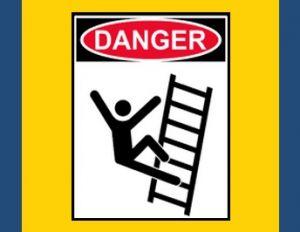Fall Prevention 101
October 4, 2018

Fall Prevention
Working at heights carries risk. About five American construction workers are killed every week by falls from heights. New data from the Census of Fatal Occupational Injuries (CFOI) show you don’t have to fall very far for the fall to be deadly. In 2011, CFOI began collecting information on the height of fatal falls. In construction, almost half of the fatal falls (48.8 percent) were from 20 feet or less, 14 percent were from ten feet or less and some were even less than six feet. Why are falls, even from six to ten feet so dangerous? The data show that the largest percentage of the fatalities are from head injuries (over 37 percent), other fatal effects from a fall include spinal cord injuries, and injuries to the major arteries and vital organs in the abdomen and pelvis.
Three Points of Contact
How can you keep your workforce safe? Conduct regular inspections on extension ladders. Inspect the rails, rungs, feet and rung locks every time a ladder is used. If damage is noted, tag it “do not use” and obtain another ladder. Use the correct ladder for the job. Make sure the ladder will support both the worker’s weight and their toolbelt. When using stepladders for repair work, never climb a stepladder in the closed position or leaning against something, and do not stand higher than the second step from the top. While climbing a ladder, always use both hands when climbing up and down. There should always be three points of contact. Workers should avoid over reaching to the side when on the ladder and excessive push and pull forces as this can destabilize the ladder and lead to a fall.
Extension Ladder placement tips:
- Set the ladder on a stable, solid base at a 4:1 angle: for every 4 rungs, place the ladder back 1 foot.
- Make sure the ladder extends 3 feet above the landing.
- Check placement by putting your feet on the feet of the ladder, if your arms are out straight in front of you, you should just be able to touch a ladder rung.
- Use the NIOSH Ladder Safety app to check ladder placement:
https://www.cdc.gov/niosh/docs/2017-129/
- Secure the ladder;
- Screw a 2’x4’ cleat to the ground behind the ladder’s feet to prevent it from slipping backwards.
- Tie off the top of the ladder, and the bottom if possible to prevent it from slipping sideways.
Fall Prevention Falls from heights (including stepladders and one-story structures) are more likely to result in death, but slips, trips, and falls on the same level are more common and can still cause serious injury. Slipping feet at any height can lead to a serious fall. When working in wet or slippery areas, use slip-resistant footwear.
Recommendations
·Use footwear labelled as slip-resistant when working in wet or slippery areas
·Never climb a stepladder in the closed position or leaning against something
·Do not stand higher than the second step from the top on a stepladder
·When climbing a ladder, use three points of contact, and do not overreach to the side of the ladder, and do not pull or push extensively since this can destabilize the ladder and lead to a fall.
For More Information:
·Slip, Trip, and Fall Prevention Guide (http://www.cdc.gov/niosh/docs/2011-123/pdfs/2011-123.pdf)
·GRIP Rating Scheme for the Slip Resistance of Footwear (https://www.hsl.gov.uk/publications-and-products/grip/grip-ratings)
References:
https://www.osha.gov/SLTC/fallprotection/
https://lhsfna.org/the-dangers-of-heights
https://www.cpwr.com/wp-content/uploads/publications/CPWR_Falls_Extension_Ladders_1.pdf